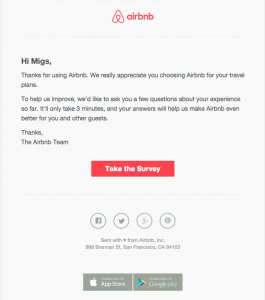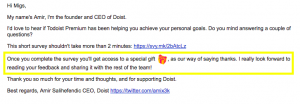An effective customer feedback survey is a great tool for collecting valuable information from your customers.
By requesting feedback through surveying, you can:
- Find out what customers really think and how they really feel about your company
- Achieve a more accurate and complete understanding of the customer experience
- Identify, manage, and resolve any high-impact issues and weaknesses
- Evaluate loyalty and satisfaction
- Identify brand advocates and promoters who are likely to recommend you to others
- Gain valuable insights essential to improving your product or service
Simply put: effective customer feedback surveys can help drive business performance and make a positive impact on your bottom line. In fact, according to SurveyMonkey, businesses that conduct customer feedback surveys are 33 percent more likely to describe themselves as successful than those who don’t.
16 Keys to a Successful Customer Feedback Survey
Getting started with creating a customer feedback survey or customer experience survey? Here are 16 essential keys to help you ask the right questions, garner high response rates, get actionable results, and become a truly customer-centric brand.
Key 1: Know your goals. There’s no point in designing the survey if you are unsure of what exactly you’re going to do with the results. Are you trying to measure loyalty? Gauge what customers think of your website or app? Or do you want to get feedback on how you’re doing with customer service? Only by identifying your goals from the very start will you be able to ask the right survey questions and collect the right information.
Key 2: Brand it. You already have a pre-existing relationship with customers. By all means, take advantage of it.
Add your logo, your brand colors, and some high-quality graphics and content to your survey. That way, it looks familiar or recognizable to your respondents. You definitely don’t want them to feel suspicious of what you’re sending.
Key 3: Apply best practices in e-mail marketing. Chances are that you’ll be distributing your customer feedback survey through e-mail, among other channels. So keep this in mind: before you can achieve high survey response rates, you have to ensure high delivery and open rates.
You can design the most dazzling survey in the world, but if you don’t put careful thought to your e-mails, you probably won’t get good results.

E-mail screenshot May 2017)
One great example of invite e-mails done right is the above one from online marketplace and homestay network Airbnb. Why is it so good? Let’s break it down:
- The e-mail starts on a warm, appreciative note: with a greeting that also serves as a thank-you message for the recipient using their service.
- In one sentence, it tells the recipient what the survey is for (“To help us improve”).
- Airbnb also specifies the commitment time — “It’ll only take 3 minutes” — which your e-mail should indicate, too. It’s important to let your recipients know how long the survey will take; otherwise, you’re making it easier for them to ignore your request.
- There’s a big call to action (CTA) for taking the recipients to the survey form.
- And the e-mail is branded! The Airbnb logo, links to social media profiles, business address, links to the app: it’s all there.
Key 4: Set the tone with a survey title and description. Before you think of the questions you’re going to ask, come up with a good title and description to succinctly describe what the survey is for and why the customers are doing it.
For respondents, customer feedback surveys are probably not the most fun thing to do ever, but at least reassure them that there’s a purpose to what they’re doing, that you’re giving them a voice to share their thoughts and opinions, and that you’re going to take what you learn in order to provide them with a better experience.
Key 5: Keep it short. When was the last time you took a 30-minute survey? Probably never. If your own customer feedback survey takes too long to finish, you run the risk of respondents abandoning it before completion.
Keep it short. Keep it simple. And avoid unnecessary questions or phrases that your customers are unlikely to understand.
Key 6: Have a progress bar. Or at least some visual cue that indicates where the respondents are as they progress through your customer feedback survey. It could be page numbers, or some other unique graphic you thought of. The key is to show that you respect your respondents’ time, which can then encourage higher response and completion rates.
Key 7: Don’t ask unnecessary questions. Remember: keep it short. Do you really need to know your customer’s age, marital status, and income bracket? Do you really have to ask where they first heard about your brand?
Before distributing your survey, go through at least one round of cutting unnecessary questions. Only those that are aligned with your objectives should make the final cut.
Key 8: If you’re going to ask for a rating, ask right away. Some companies leave it until the end before they ask for an overall rating. We don’t think this is ideal.
Why? Because it’s a crucial question or request that practically demands a gut reaction, and if you’re going to ask for a rating after a 5- to 10-minute round of less important questions, there’s a chance that you might invalidate the customer’s response.
Key 9: Ensure rating scale consistency. Many surveys include rating scales to help measure customer feedback more accurately. For simplicity and clarity, keep the scale direction consistent.
If, on a scale of 1 to 5, 1 means “strongly disagree” and 5 means “strongly agree,” make sure that when you change the context of your questions, the highest value will continue to be assigned to the best outcome — say, 1 means “least important” and 5 means “most important.”
Not only does this minimize respondent confusion; standard, consistent scaling also makes it easier for you to conduct analysis.
Key 10: Have middle options. Whatever scale you decide to use, provide a middle category or neutral option. It gives respondents a kind of “out” if they are not sure how to answer or if they happen to have mixed feelings or sentiment. More importantly (and this is backed by research studies), middle options result in better, more accurate data.
Key 11: Not using scales? Stick to “Yes” or “No” questions, or provide pre-selected / multiple-choice answers. One of the keys to creating an effective customer feedback survey is how you frame your questions. As much as possible, ask closed-ended questions, those that can only be answered with a “Yes” or a “No.”
If your questions require responses that are a little bit more elaborate, provide pre-selected answers that are easy to understand and choose from.
Key 12: Ask open-ended questions, too. For ease and simplicity, your customer feedback survey will have mainly scales and closed-ended questions and multiple choices. But this shouldn’t stop you from adding, at the end of the survey, open-ended questions and a text box for respondents to type in.
This gives them an opportunity to express themselves and articulate their thoughts in free-form text. Moreover, open-ended questions at the end of the survey often lead to the most insightful responses and feedback.
Key 13: Consider giving incentives. There are customers who will take your survey without needing a reward. But incentives have been proven to improve response rates, so go for it if you have the resources. Think discounts, gift cards, free coffee, an extended product trial, or account credit.

E-mail screenshot Nov 2016)
Key 14: Add a Thank You page. It’s de rigueur to show your appreciation for respondents who complete your customer feedback survey. You can do this with a simple Thank You page, complete with a message that lets respondents know that their feedback has successfully been collected.
Key 15: Respond to customer feedback. If you received negative feedback from your survey, act quickly and respond to let customers know that you are already working on delivering a better experience next time. Let them know that you’re on it. Make a phone call, send an e-mail, or write a handwritten note. The key is to respond in a timely manner; otherwise, you run the risk of leaving unhappy customers stewing.
Key 16: Share the insights with your team. The voice of the customer is one of your company’s greatest sources of learning. Once you have collected and analyzed the results of your customer feedback survey, be sure to share the insights you have discovered to key decision-makers and stakeholders in your organization.
Congrats on your commitment to becoming a truly customer-centric brand, and good luck on creating your customer feedback survey!



